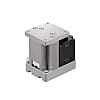(!) Since support from Microsoft will end on January 14 2020, Windows 7 user might not be able to use MISUMI website effectively. Please consider to update your system as ‘MISUMI Website system requirement’.
SURUGA SEIKI Z-Axis(Feeding Method:Ball Screw)
SURUGA SEIKI offers products Z-Axis specified by Feeding Method Ball Screw from Automation Components product category. There are a total of 1 items. Search and select detailed specifications of parts for your machine with free CAD downloads. SURUGA SEIKI products are available to order through MISUMI online 24 hours a day. Free shipping, no minimum order.
Configure
Specification/Dimensions
-
Load Capacity (Range)(N)
-
Motor, Motor Characteristics
- 5-Phase Stepping Motor - Standard
- 5-Phase Stepping Motor - High Torque
- 5-Phase Stepping Motor - High Resolution
- 5-Phase Stepping Motor with Brake
- α-Step Motor
- 2-Phase Stepping Motor - Standard
-
Table Material
- Steel
- Stainless Steel
- Aluminum
-
Travel Guide
- Cross Roller
- Linear Ball
-
Minimum Resolution(µm)
-
Stroke (Z Distance)(mm)
-
Feeding Method
- Ball Screw
-
Type
- Z-Axis Stage
-
Table Size (Length) L(mm)
-
Table Size (Width) W(mm)
-
Z-Axis Stage Surface
-
Sensor
Brand |
|
|---|---|
| CAD |
|
- 1 items
- Sort By
-
You can add up to 6 items per a category to the compare list.



Horizontal Surface Z-Axis Stage
SURUGA SEIKI
Specialized in only the necessary functionality, helping keep costs down.From: ฿ 44,952.59 Days to Ship: 8 Day(s)
8 Day(s)
| Brand |
|---|
| Product Series |
| CAD |
| From |
| Days to Ship |
| Load Capacity (Range)(N) |
| Motor, Motor Characteristics |
| Table Material |
| Travel Guide |
| Minimum Resolution(µm) |
| Stroke (Z Distance)(mm) |
| Feeding Method |
| Type |
| Table Size (Length) L(mm) |
| Table Size (Width) W(mm) |
| Z-Axis Stage Surface |
| Sensor |
You can add up to 6 items per a category to the compare list. | |
| Brand | SURUGA SEIKI |
| Product Series | |
| CAD |
|
| From | ฿ 44,952.59 |
| Days to Ship | 8 Day(s) |
| Load Capacity (Range)(N) | 5~30 / 30.1~50 |
| Motor, Motor Characteristics | 5-Phase Stepping Motor - Standard |
| Table Material | Steel |
| Travel Guide | Linear Ball |
| Minimum Resolution(µm) | 2 |
| Stroke (Z Distance)(mm) | 6 ~ 8 |
| Feeding Method | Ball Screw |
| Type | Z-Axis Stage |
| Table Size (Length) L(mm) | 40 ~ 60 |
| Table Size (Width) W(mm) | 40 ~ 60 |
| Z-Axis Stage Surface | Horizontal |
| Sensor | Limit + Home |
Loading...
Related Categories to Z-Axis
FAQ Z-Axis stage
- Question: What is a Z-Axis Stage?
- Answer: A Z-Axis stage, also known as a vertical stage, is a precision positioning device that allows for controlled vertical movement. It is commonly used in applications requiring fine adjustments in the vertical plane, such as microscopy, wafer inspection, and material testing.
- Question: How do Z-Axis Stages Work?
- Answer: Z-Axis stages operate by constraining motion to the vertical axis while minimizing movement in other degrees of freedom (pitch, yaw, roll, and X/Y translation). This is achieved using various mechanisms such as dovetail grooves, cross-roller bearings, or wedge designs. Some stages use magnetic or pneumatic counterbalances to offset the effects of gravity and reduce the load on the motor.
- Question: What Types of Z-Axis Stages are Available?
- Answer: There are several types of Z-Axis stages, including:
- Manual Z-Axis Stages: These stages are adjusted manually using micrometers or adjustment screws, suitable for applications requiring less frequent adjustments.
- Motorized Z-Axis Stages: These stages are driven by motors (stepper or servo) and are used in applications requiring automated or precise repeatable movements. They can be controlled via software for high precision tasks.
- Piezo-Assist Stages: These combine traditional mechanical movement with piezoelectric elements for ultra-fine adjustments. They are often used in nanotechnology and high-precision optics. - Question: How to Choose the Right Z-Axis Stage?
- Answer: Selecting the appropriate Z-Axis stage depends on several factors:
- Travel Range: Determine the maximum vertical travel required for your application. Stages vary from a few millimeters to several centimeters.
- Load Capacity: Ensure the stage can support the weight of the load, including any additional equipment like cameras or sensors.
- Resolution and Repeatability: Higher resolution stages provide finer control, essential for applications like microscopy where precise focus is critical. Repeatability indicates how consistently the stage can return to a set position.
- Type of Drive Mechanism: Manual stages are suitable for less frequent adjustments, while motorized stages are better for automated processes. Piezo stages are ideal for applications requiring nanometer-scale precision.
- Environmental Compatibility: Consider if the stage needs to operate in vacuum conditions, cleanrooms, or other specific environments. - Question: What are the Common Applications of Z-Axis Stages?
- Answer: Z-Axis stages are used in a variety of high-precision applications:
- Microscopy: For focusing objectives and scanning samples.
- Wafer Inspection: In semiconductor manufacturing to inspect and process wafers.
- Material Testing: To apply and measure forces vertically on test samples.
- Optical Alignment: To adjust components in optical systems. - Question: How to Maintain a Z-Axis Stage?
- Answer: Regular maintenance ensures optimal performance and longevity of Z-Axis stages:
- Cleaning: Keep the stage free of dust and debris. Use appropriate cleaning agents compatible with the stage materials.
- Lubrication: Periodically lubricate moving parts if specified by the manufacturer.
- Calibration: Regularly check and calibrate the stage to maintain accuracy, especially in critical applications.








How can we improve?
How can we improve?